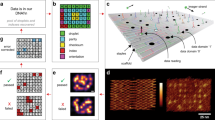Abstract
We present the design of a novel, irreversible memory element for use in artificial DNA-based computing systems and provide ‘wet-ware’ demonstrations of the validity of key assumptions of our design. The mechanism makes use of a DNA switch with a rotatable mid-section that contains a bacterial promoter and non-rotatable end sections, each of which contains a gene encoding a different fluorescent protein. The state (orientation) of the rotatable mid-section is therefore reported by the fluorescent colour produced when the plasmid is in a system that permits transcription and translation. Rotation of the mid-section from the ‘unset’ to the ‘set’ state is achieved by digestion of specific sites on the switch by the asymmetric restriction enzyme, Bpu10I, followed by ligation. Once set, the rotatable section cannot be cut again by the enzyme, so that state is held irreversibly even when exposed again to the switching signal. This mechanism has potential applications for permanently recording, in DNA, the occurrence of transient events.






Similar content being viewed by others
References
Adleman LM (1994) Molecular computation of solutions to combinatorial problems. Science 266:1021–1024
Atkinson MR, Savageau MA, Myers JT, Ninfa AJ (2003) Development of genetic circuitry exhibiting toggle switch or oscillatory behavior in Escherichia coli. Cell 113:597–607
Benenson Y, Paz-Elizur T, Adar R, Keinan E, Livneh Z, Shapiro E (2001) Programmable and autonomous computing machine made of biomolecules. Nature 414:430–434
Braich RS, Chelyapov N, Johnson C, Rothemund PW, Adleman L (2002) Solution of a 20-variable 3-SAT problem on a DNA computer. Science 296:499–502
Cai J, DuBow MS (1997) Use of a luminescent bacterial biosensor for biomonitoring and characterization of arsenic toxicity of chromated copper arsenate (CCA). Biodegradation 8:105–111
Chang WL, Guo M, Ho MS (2005) Fast parallel molecular algorithms for DNA-based computation: factoring integers. IEEE Trans Nanobioscience 4:149–163
Elowitz MB, Leibler S (2000) A synthetic oscillatory network of transcriptional regulators. Nature 403:335–338
Forster AC, Church GM (2006) Towards synthesis of a minimal cell. Mol Syst Biol 2:45
Gardner TS, Cantor CR, Collins JJ (2000) Construction of a genetic toggle switch in Escherichia coli. Nature 403:339–342
Gomada M, Inouye S, Imaishi H, Nakazawa A, Nakazawa T (1992) Analysis of an upstream regulatory sequence required for activation of the regulatory gene xylS in xylene metabolism directed by the TOL plasmid of Pseudomonas putida. Mol Gen Genet 233:419–426
Grilione PL, Carr JH (1960) Isolation and study of a bacteriophage for bacillus pumilus. J Bacteriol 80:47–50
Hasty J, McMillen D, Collins JJ (2002) Engineered gene circuits. Nature 420:224–230
Ikariyama Y, Nishiguchi S, Koyama T, Kobatake E, Aizawa M, Tsuda M, Nakazawa T (1997) Fiber-optic-based biomonitoring of benzene derivatives by recombinant E. coli bearing luciferase gene-fused TOL-plasmid immobilized on the fiber-optic end. Anal Chem 69:2600–2605
Inouye S, Nakazawa A, Nakazawa T (1983) Molecular cloning of regulatory gene xylR and operator-promoter regions of the xylABC and xylDEGF operons of the TOL plasmid. J Bacteriol 155:1192–1199
Inouye S, Nakazawa A, Nakazawa T (1987) Expression of the regulatory gene xylS on the TOL plasmid is positively controlled by the xylR gene product. Proc Natl Acad Sci USA 84:5182–5186
Kramer BP, Viretta AU, Daoud-El-Baba M, Aubel D, Weber W, Fussenegger M (2004) An engineered epigenetic transgene switch in mammalian cells. Nat Biotechnol 22:867–870
Lovett PS (1972) PBPI: a flagella specific bacteriophage mediating transduction in Bacillus pumilus. Virology 47:743–752
Narita M, Yamagata T, Ishii H, Huang CC, Endo G (2002) Simultaneous detection and removal of organomercurial compounds by using the genetic expression system of an organomercury lyase from the transposon Tn MERI1. Appl Microbiol Biotechnol 59:86–90
Rabbow E, Rettberg P, Baumstark-Khan C, Horneck G (2003) The sos-lux-lac-fluoro-toxicity-test on the International Space Station (ISS). Adv Space Res 31:1513–1524
Stankevicius K, Lubys A, Timinskas A, Vaitkevicius D, Janulaitis A (1998) Cloning and analysis of the four genes coding for Bpu10I restriction-modification enzymes. Nucleic Acids Res 26:1084–1091
Acknowledgements
We would like to thank Darren Logan and Jane Armstrong for discussions and Jean Pierre Lavergne, Kendra White and Matthias Ehrmann for supplying a discontinued plasmid.
Author information
Authors and Affiliations
Corresponding author
Rights and permissions
About this article
Cite this article
Blenkiron, M., Arvind, D.K. & Davies, J.A. Design of an irreversible DNA memory element. Nat Comput 6, 403–411 (2007). https://doi.org/10.1007/s11047-007-9051-y
Received:
Accepted:
Published:
Issue Date:
DOI: https://doi.org/10.1007/s11047-007-9051-y




